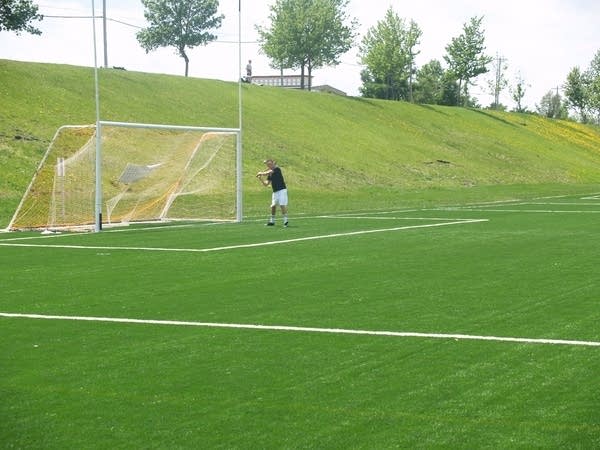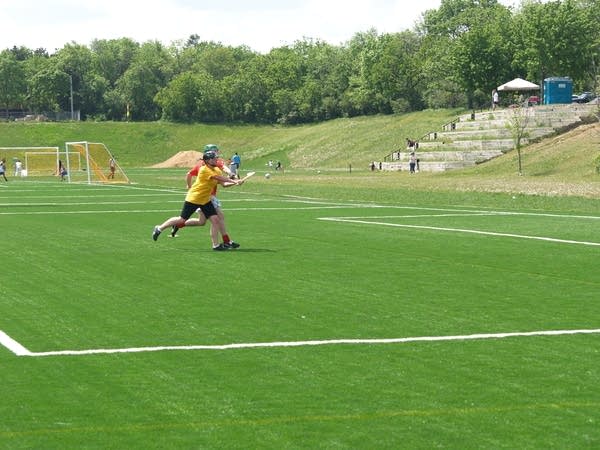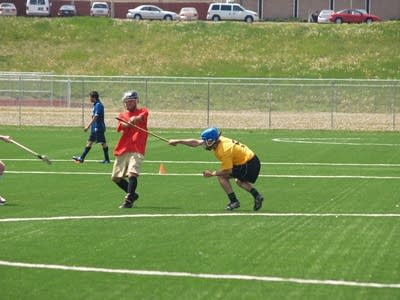Local enthusiasts build ancient Irish sport in St. Paul
Go Deeper.
Create an account or log in to save stories.
Like this?
Thanks for liking this story! We have added it to a list of your favorite stories.

Hurling looks a little like field hockey, but only a little.
Two teams of brightly shirted players tear up and down the artificial turf at the McMurray fields, brandishing sticks shaped like giant asymmetrical wooden spoons. They run like greyhounds, crashing into one another, slashing like swordsmen. They regularly send the ball the length of the field.

"A bunch of us got together because we decided that the bar wasn't interesting enough without having something to do beforehand," said Adam Coolong. "So we decided to run around on a big field and hit each other with sticks."
Coolong is a relatively recent convert to hurling.
Turn Up Your Support
MPR News helps you turn down the noise and build shared understanding. Turn up your support for this public resource and keep trusted journalism accessible to all.
"I always like to describe it as a distilled version of the best skills from American games like baseball and ice hockey, and obviously not an American game but golf," said Coolong. "You have catching the ball in the air, and hitting them in the air with sticks, and running like soccer, a little bit of tackling like rugby."
The stick is called a hurley. Players use it to scoop, whack, and block a ball called a sliotar. A sliotar is like a baseball with a slightly more raised seam.
Killian Conlon is in charge of training at the club. He says the hurleys are about three feet long and made of ash.

"These have a tendency to break, thankfully," he said. "When it's hurley on bone, that's a helpful thing." Condon says the hurley and the sliotar is all you need. Oh, and a helmet too.
"The helmet is the necessity for the game," Condon said. "It's a very skillful game, but sometimes you get the odd stray hurley in the air and it could hit you. I've been split over the eye once or twice."
For all its fearsomeness, there are remarkably few injuries.
"I think they describe it as the most skillful game on the field," Condon said. "There are something like 300 skills on the field, but I'm not quite sure what they all are."

Actually, Condon is held as one of the local masters of the game, a player who is so skilled and accurate he can score from well inside his own half.
The goal is shaped like a football goalpost, with a soccer net under the crossbar.
Get the ball over the bar between the posts, it's a point. Get it under the bar between the posts, past the goalie with the really big hurley, it's three points.
Irish expats formed Twin Cities Robert Emmets Hurling club formed just three years ago.

They have recruited a lot of locals since, teaching them the skills of the game. The club is now predominantly American. At 51, Jim Leinfelder is cheerfully the oldest man on the field.
The match being played here is the first in a new Twin Cities pub league. Club members have been training for some weeks. But this is the first game this season where the score counts.
Leinfelder says it's drawing out the experienced Irish players.
"Because the native Irish players know hurling," Leinfelder said. "They've been playing since they were kids. For us American players, we are thrilled every time we come out and manage to do something correctly, but they've mastered it long ago back in Ireland. So they need competition -- these guys are fierce, fierce competitors. So as soon as they start keeping a score they start to turn up."

He points to a player with a neatly trimmed red goatee.
"There's a man to talk to right there," Leinfelder said.
"Oh, no. I don't speak English at all," the man quickly responded with a thick Irish accent.
But he does. He's John Kenneally from County Cork, a hurling hotbed. He says when he moved to the U.S. he didn't expect to keep playing, but he's been pleased to find the St. Paul club.
"We've got three or four exceptionally good American players here, and that's good to see. And it's strange to see, too, to see an American pick up a hurley and kinda doing well. But it's great to see it," Kenneally said. The Twin Cities Robert Emmets Hurling Club is eager to recruit new players, and will welcome anyone who wants to turn up and give it a lash, as the Irish players say.

One hurler is particularly eager.
Her name is Stephanie MacAlpine. She wants more women to play. The other hurlers are in awe of her. She had a baby less than three months ago.
"I wanted to play something," MacAlpine said. "And this is a fast team sport, not like softball. And it's exercise, and I just had a baby, so exercise is a good thing."
While it's a young club, the Twin Cities Robert Emmets did pretty well in the National North American Gaelic Athletic Associations championships last year. It took second place in the junior division.
Teams will be heading out to Boston over Labor Day for this year's finals, too.






